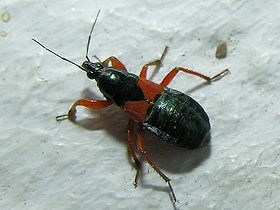Sickle bugs
| Sickle bugs | ||||||||||||
|---|---|---|---|---|---|---|---|---|---|---|---|---|

|
||||||||||||
| Systematics | ||||||||||||
|
||||||||||||
| Scientific name | ||||||||||||
| Nabidae | ||||||||||||
| Costa , 1852 | ||||||||||||
| Subfamilies | ||||||||||||
Sickle bugs (Nabidae) are a family of bed bugs (Heteroptera) that are found worldwide . The distinguishing feature of these insects (Insecta) is their sickle-shaped, curved proboscis (rostrum), with which they suck other insects and arthropods as exclusive predators . As beneficial insects against arthropods, sickle bugs are important in agriculture and horticulture.
Systematics
The sickle bug family comprises around 500 species in 21 genera worldwide. A distinction is made between two kinship groups or subfamilies , which differ in their shape and, above all, in the form of sperm transmission: the more species-rich and slimmer Nabinae with mostly yellow-brown camouflage and the less common, predominantly more robustly built prostem matinae with predominantly black-red, rare black and yellow warning dress . Both groups are represented in Europe. 40 species have been identified here.
Distribution and habitats
Sickle bugs are common worldwide. They colonize a variety of different habitats. They live on the surface of the soil, in layers of herbs and in tree tops, with the individual species colonizing their own preferred areas. They can be found in forests and bushes as well as in open land biotopes such as meadows and other grass and herb fields.
general characteristics
The sickle bugs of the Central European fauna are between 5.5 and 11 millimeters long. While most species are built more or less slender, in some species the abdomen is noticeably widened. The four-part proboscis is curved into a sickle shape - hence the German name. This resembles the tripartite, much stronger rostrum of the predatory bugs (Reduviidae). In most species, a more or less distinct neck ring is developed in front of the pronotum . The four or five-limbed antennae are long and thin, as long or shorter than the body. The forelegs are also long and thin or, in some species, are sturdy robotic legs with thighs that are often clearly thickened and thorny ( femur ). The compound eyes are often spherical; Point eyes ( Ocelli ) are present. Long-winged forms are rare and mostly only occur in females.
nutrition
Sickle bugs are exclusively predatory. They suckle at all stages of development of insects and other arthropods. Most species are not very particular about their prey. They are polyphagous . Others, on the other hand, specialize in a limited range of prey, such as most representatives of the prostemmatinae. The Nabinae pierce their prey with the long forward stretched rostrum, whereby the thin front legs are rarely used. The species of the subfamily of the Prostemmatinae grab their prey, however, with the clearly stronger forelegs developed into robbery legs and hold them tight. The widened and thorny thighs as well as areas of adhesive hair at the end of the front and middle legs, so-called "sponge soles", support the holding of the prey.
Reproduction and development
The conjugation is carried out intravaginally at the nabidae, the insemination of eggs in the field of ovarioles takes place. In the Nabinae, the sperm reach the eggs via the fallopian tubes. In contrast, the representatives of the prostemmatinae experience what is known as “traumatic insemination ”. The aedeagus pierces the wall of the vagina, whereby the sperm enter the body cavity. The sperm swim to the ovaries, bypassing the ovaries.
The Central European species only go through one generation a year. The hemimetabolic animals overwinter in the egg or adult stage. The eggs are sunk by the females into plant tissue, usually in the hollow stalks of grass , with the help of their ovipositor . In egg hibernators, the eggs are laid in autumn. With the warming in spring, the first larvae hatch. In the case of the imaginal hibernators, the eggs are laid in spring. The animals, which grow up until autumn, overwinter. Since the mortality rate of males is significantly higher than that of females, females are predominantly found in spring.
Species in Europe
The following species occur in Europe:
Subfamily Nabinae:
- Himacerus apterus ( Fabricius , 1798)
- Himacerus boops ( Schiødte , 1870)
- Himacerus dauricus ( Kiritshenko , 1911)
- Himacerus major ( A. Costa , 1842)
- Himacerus mirmicoides ( O. Costa , 1834)
- Nabis brevis Scholtz , 1847
- Nabis capsiformis Germar , 1838
- Nabis christophi Dohrn , 1862
- Nabis ericetorum Scholtz , 1847
- Nabis ferus ( Linnaeus , 1758)
- Nabis flavomarginatus Scholtz , 1847
- Nabis hispanicus Remane , 1964
- Nabis inscriptus ( Kirby , 1837)
- Nabis limbatus Dahlbom , 1851
- Nabis lineatus Dahlbom , 1851
- Nabis mediterraneus Remane , 1962
- Nabis meridionalis Kerzhner , 1963
- Nabis occidentalis ( Kerzhner , 1963)
- Nabis palifer Seidenstucker , 1954
- Nabis pallidus fever , 1861
- Nabis persimilis Reuter , 1890
- Nabis ponticus ( Kerzhner , 1962)
- Nabis provencalis Remane , 1953
- Nabis pseudoferus Remane , 1949
- Nabis punctatus A. Costa , 1847
- Nabis reuterianus Puton , 1880
- Nabis riegeri Kerzhner , 1996
- Nabis rugosus ( Linnaeus , 1758)
- Nabis sareptanus Dohrn , 1862
- Nabis tesquorum ( Kerzhner , 1968)
- Nabis viridulus Spinola , 1837
Subfamily Prostemmatinae:
- Alloeorhynchus flavipes ( fever , 1836)
- Alloeorhynchus putoni Kirkaldy , 1901
- Phorticus velutinus Puton , 1895
- Prostemma aeneicolle stone , 1857
- Prostemma albimacula stone , 1857
- Prostemma bicolor Rambur , 1839
- Prostemma guttula ( Fabricius , 1787)
- Prostemma sanguineum ( Rossi , 1790)
Single sources
literature
- E. Wachmann , A. Melber & J. Deckert: Bugs. Volume 1: Revising the bedbugs in Germany, Austria and German-speaking Switzerland, Goecke & Evers, Keltern, 2006, pp. 157–180. ISBN 3-931374-49-1

